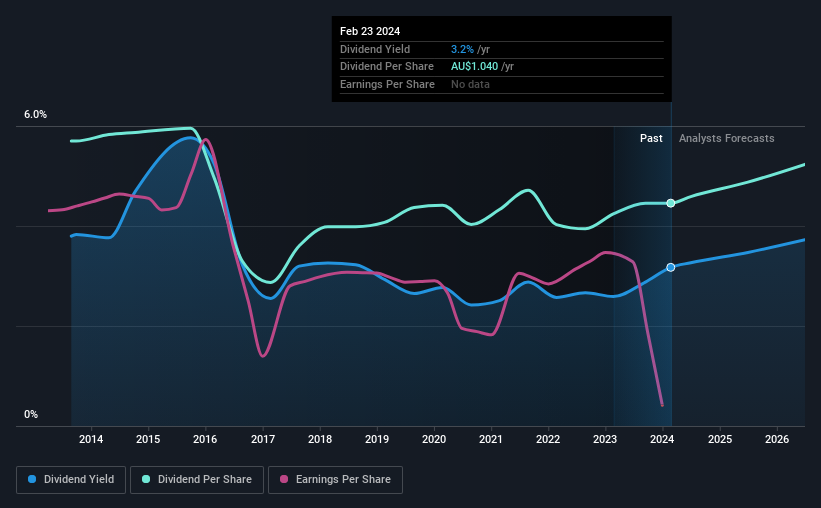Do These 3 Checks Before Buying Woolworths Group Limited (ASX:WOW) For Its Upcoming Dividend
Woolworths Group Limited (ASX:WOW) stock is about to trade ex-dividend in 4 days. The ex-dividend date is usually set to be one business day before the record date which is the cut-off date on which you must be present on the company's books as a shareholder in order to receive the dividend. The ex-dividend date is an important date to be aware of as any purchase of the stock made on or after this date might mean a late settlement that doesn't show on the record date. Thus, you can purchase Woolworths Group's shares before the 28th of February in order to receive the dividend, which the company will pay on the 11th of April.
The company's next dividend payment will be AU$0.47 per share, and in the last 12 months, the company paid a total of AU$1.04 per share. Looking at the last 12 months of distributions, Woolworths Group has a trailing yield of approximately 3.2% on its current stock price of AU$32.78. Dividends are a major contributor to investment returns for long term holders, but only if the dividend continues to be paid. As a result, readers should always check whether Woolworths Group has been able to grow its dividends, or if the dividend might be cut.
View our latest analysis for Woolworths Group
Dividends are typically paid from company earnings. If a company pays more in dividends than it earned in profit, then the dividend could be unsustainable. Woolworths Group's dividend is not well covered by earnings, as the company lost money last year. This is not a sustainable state of affairs, so it would be worth investigating if earnings are expected to recover. With the recent loss, it's important to check if the business generated enough cash to pay its dividend. If cash earnings don't cover the dividend, the company would have to pay dividends out of cash in the bank, or by borrowing money, neither of which is long-term sustainable. Thankfully its dividend payments took up just 41% of the free cash flow it generated, which is a comfortable payout ratio.
Click here to see the company's payout ratio, plus analyst estimates of its future dividends.
Have Earnings And Dividends Been Growing?
Companies with falling earnings are riskier for dividend shareholders. If earnings decline and the company is forced to cut its dividend, investors could watch the value of their investment go up in smoke. Woolworths Group reported a loss last year, and the general trend suggests its earnings have also been declining in recent years, making us wonder if the dividend is at risk.
Another key way to measure a company's dividend prospects is by measuring its historical rate of dividend growth. Woolworths Group's dividend payments per share have declined at 2.4% per year on average over the past 10 years, which is uninspiring. While it's not great that earnings and dividends per share have fallen in recent years, we're encouraged by the fact that management has trimmed the dividend rather than risk over-committing the company in a risky attempt to maintain yields to shareholders.
Remember, you can always get a snapshot of Woolworths Group's financial health, by checking our visualisation of its financial health, here.
To Sum It Up
From a dividend perspective, should investors buy or avoid Woolworths Group? First, it's not great to see the company paying a dividend despite being loss-making over the last year. On the plus side, the dividend was covered by free cash flow." It's not that we think Woolworths Group is a bad company, but these characteristics don't generally lead to outstanding dividend performance.
Although, if you're still interested in Woolworths Group and want to know more, you'll find it very useful to know what risks this stock faces. For instance, we've identified 2 warning signs for Woolworths Group (1 is a bit concerning) you should be aware of.
A common investing mistake is buying the first interesting stock you see. Here you can find a full list of high-yield dividend stocks.
Have feedback on this article? Concerned about the content? Get in touch with us directly. Alternatively, email editorial-team (at) simplywallst.com.
This article by Simply Wall St is general in nature. We provide commentary based on historical data and analyst forecasts only using an unbiased methodology and our articles are not intended to be financial advice. It does not constitute a recommendation to buy or sell any stock, and does not take account of your objectives, or your financial situation. We aim to bring you long-term focused analysis driven by fundamental data. Note that our analysis may not factor in the latest price-sensitive company announcements or qualitative material. Simply Wall St has no position in any stocks mentioned.

 Yahoo Finance
Yahoo Finance 
